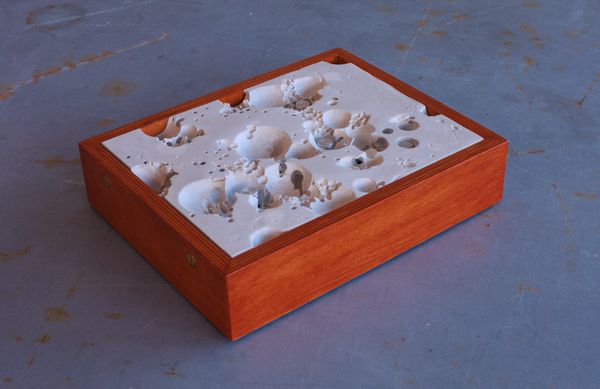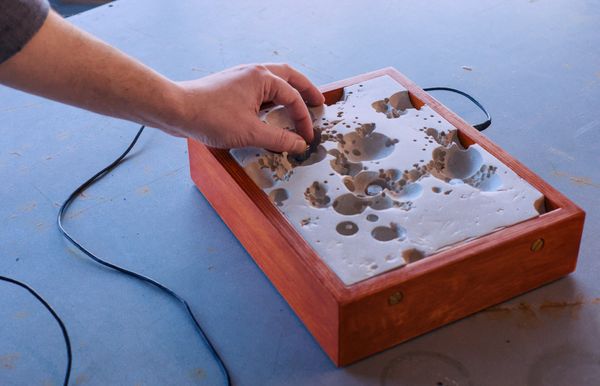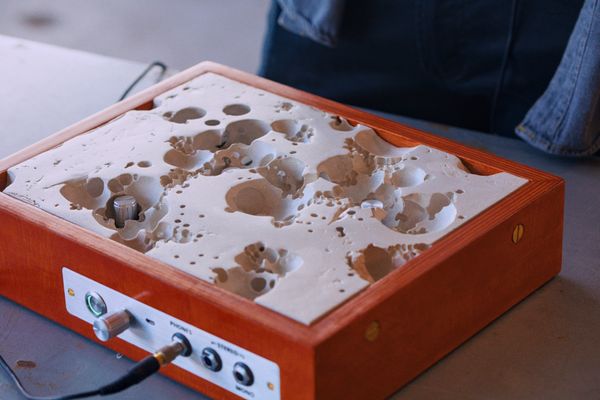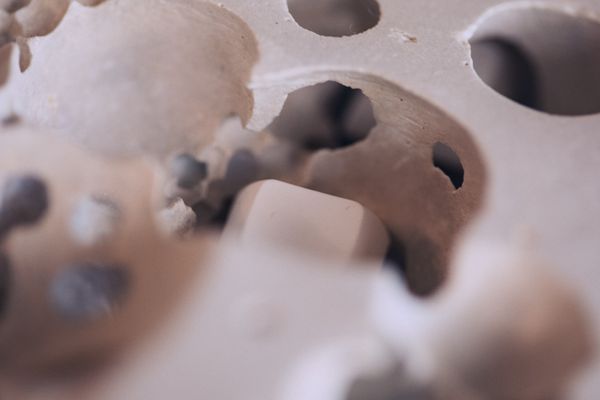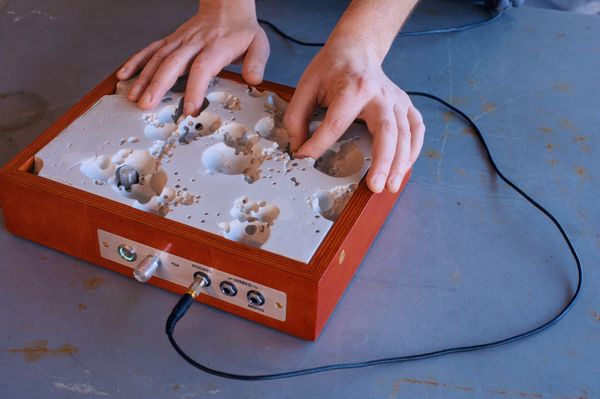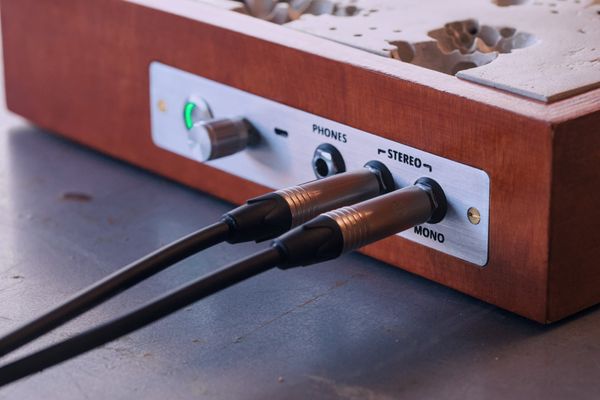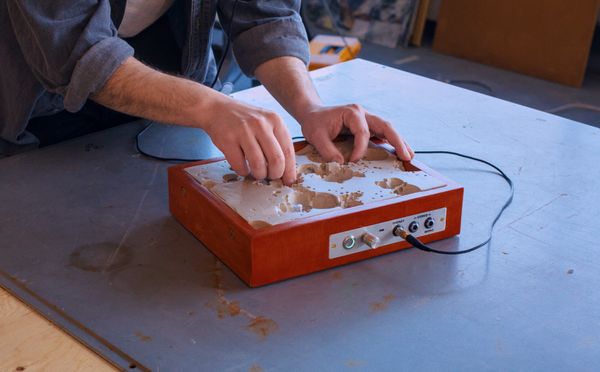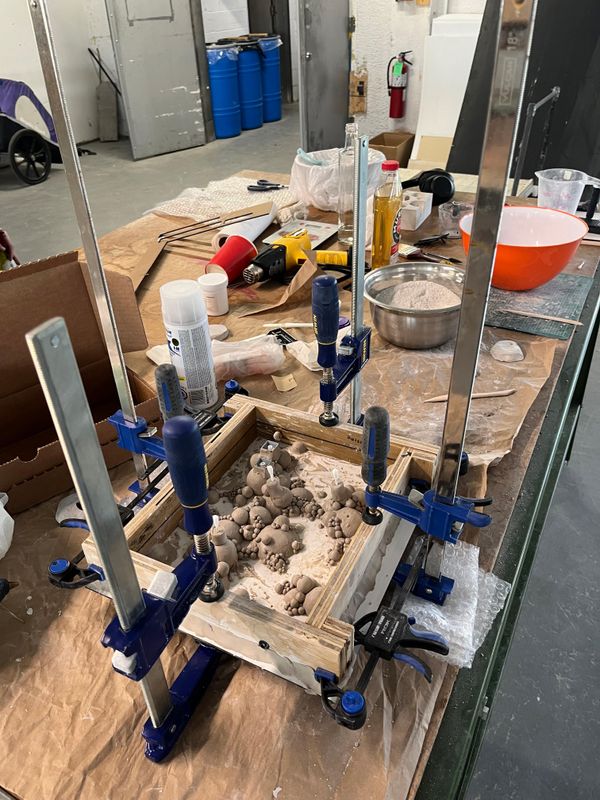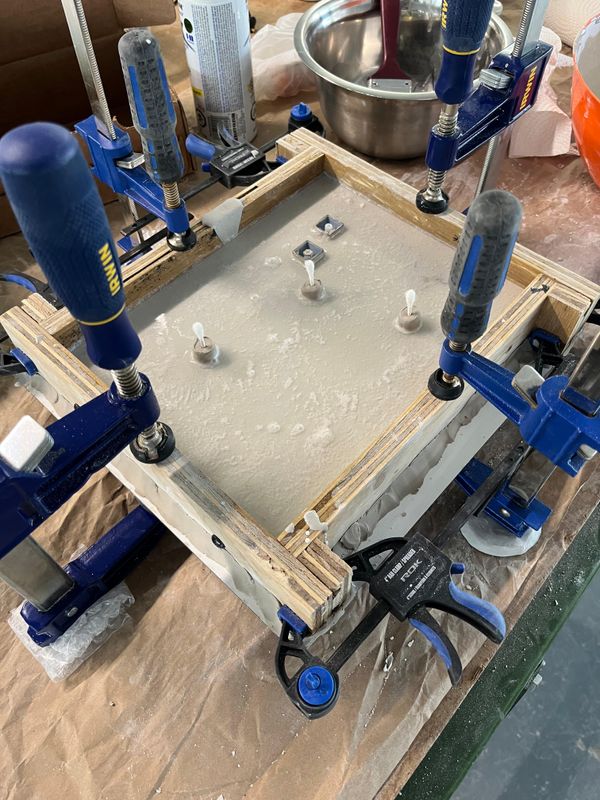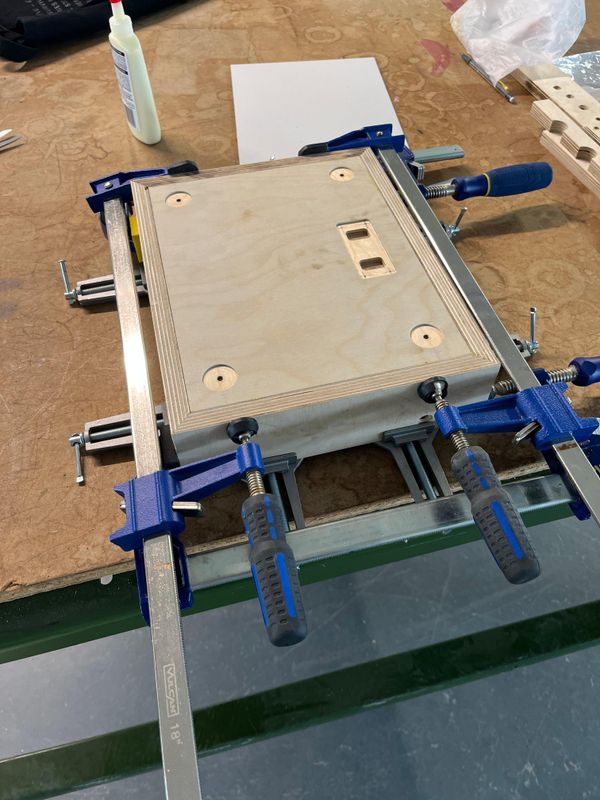Olm (2023) #
Conceived in a moment of undirected ambition, the Olm is both an interactive sculpture and a tool for randomly generating ambient soundscapes and music. It is a digital, aleatoric synthesizer housed in a hand-crafted enclosure of plywood, plaster and aluminum.
The design, reminiscent of caverns, craters, rugged rock formations, and other ambiguous topographical structures[1], aims to immerse the audience in the sensation of delving deeper into an endless cave or traversing further into an imaginary landscape. To fully engage with the piece, the audience must actively participate, navigating the fissures and openings to access the controls that orchestrate the unexpected and haunting sounds.
Usage #
The Olm may be a frustrating experience for individuals with preconceived notions about how a synthesizer should behave. Letting go of the intuition to control or shape the sound, you are freed to explore the soundscape.
The Olm produces sound by connecting to an amplifier or plugging in a pair of headphones. The sounds are sculpted by your use of the interface, which controls a constrained randomization algorithm, guiding the instruments and signal chains present on the microchip.
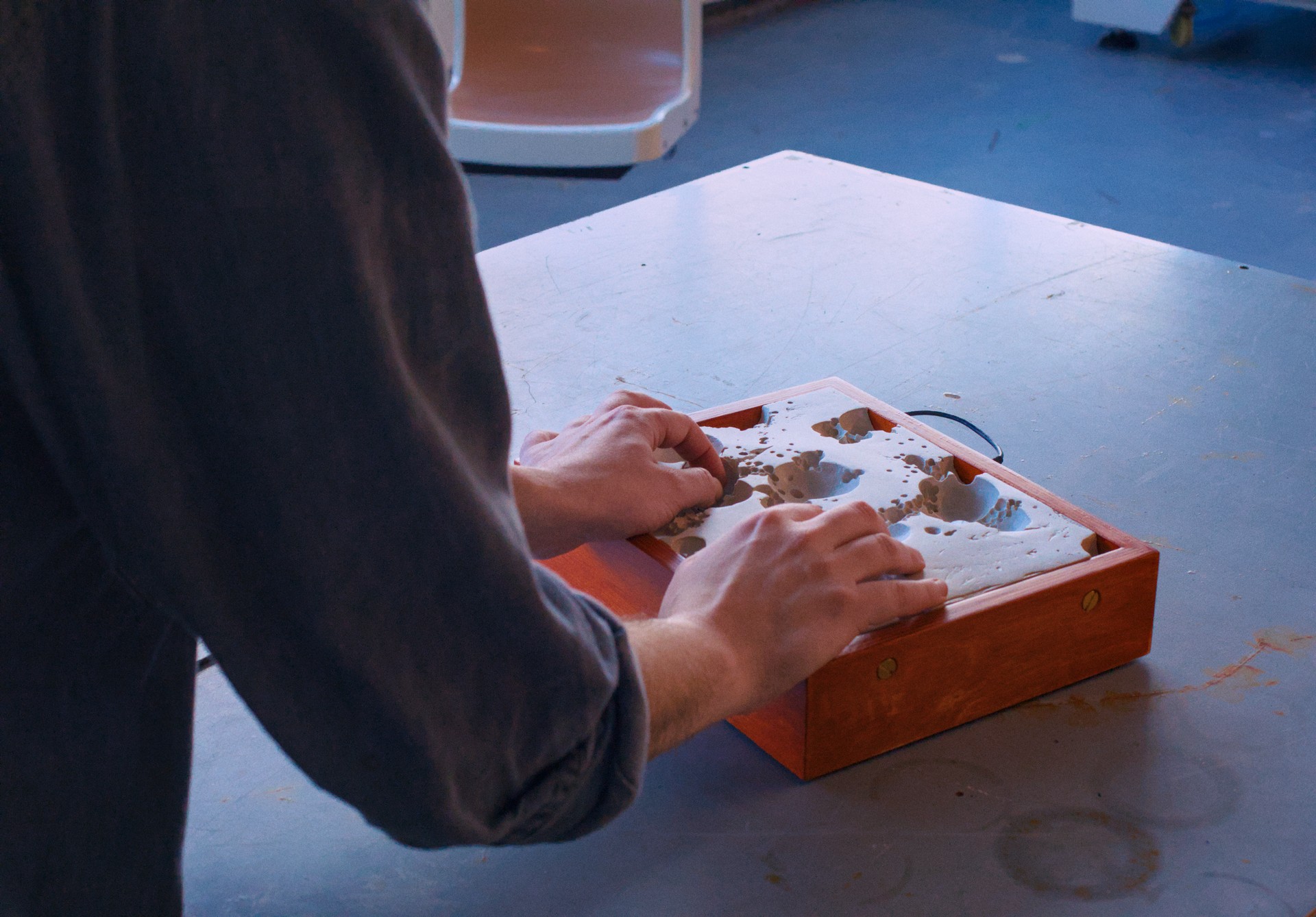
Hands on with the Olm at Les Ateliers Belleville
You have three non-continuous dials and two momentary buttons at your disposal. Rather than predictably affecting specific sonic parameters, the dials only push the randomization further, negating the ability to shape the sound to your will. When you come across something you find interesting/inspiring/terrifying you may use the buttons for storing and recalling the state of the synthesizer parameters.
Intent #
I initiated this project while navigating a job search in an industry where the rapid advancement of machine learning and large language models could soon render my skills obsolete. Determined to defy my impending obsolescence, I decided to create something hand-made and personal—an amalgamation that blends the control panels of classic synthesizers with elements of sculpture, electronics and digital synthesis. The success of this project owes much to the generosity and creativity of fellow artists and technologists in the open-source community. In the spirit of reciprocity, and to promote the free and open distribution of ideas and technology, all the source code and schematics for the project are released freely under the GPL-3 license, available from the olm-pd and olm-pcb repositories.
Cave-dwelling #

An olm swimming about its natural habitat.[2]
Deep within the karst of the Soča River basin, the slender salamander-like olm (or proteus) thrives underground and underwater, enduring a century-spanning life hunting in the darkness, remarkably surviving without food for up to a decade. This creature, enduring hunger in the darkest depths as it blindly searches for sustenance, conjures the formless, roiling, entropic chaos where spontaneous creation can happen.
Growing up, while on vacations, my parents took me to see caves in New Hampshire and "cenotes" in the Yucatan Peninsula region of Mexico. My excitement for those went hand-in-hand with my enthusiasm for video games in the Metroid and Legend of Zelda series, where I would explore similarly dark and mysterious spaces. Caves can be dark and foreboding, but they can also be a place of comfort and inspiration. In designing the Olm's interface, I wanted to capture the mixture of trepidation and exhilaration that comes with exploring subterranean spaces.
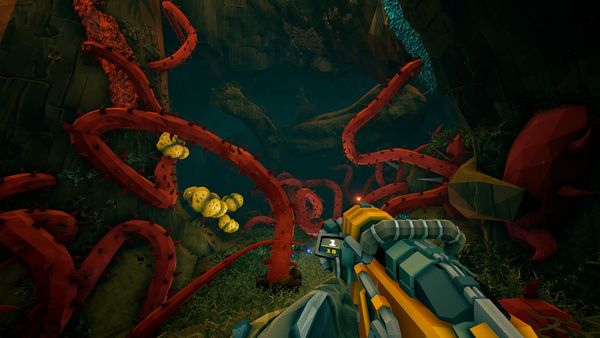
In this game, you team up with friends to delve deep into procedurally-generated mines, teeming with alien life.
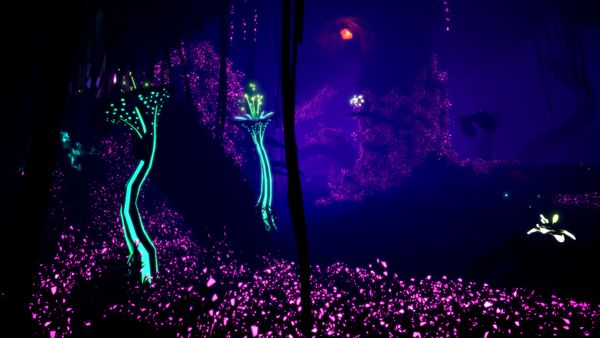
The caves generated with RNG consistently give new challenges, and surprising discoveries.
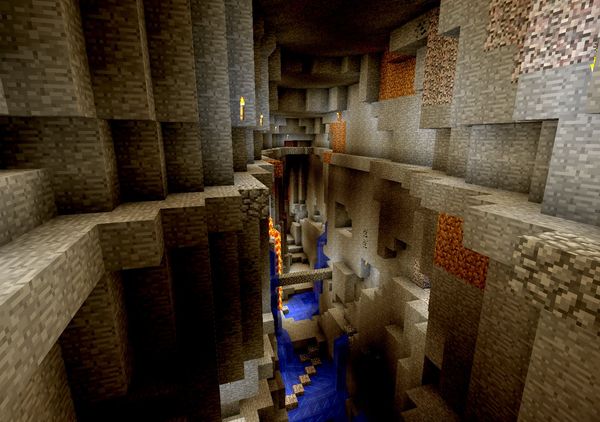

Olms are endemic to the caves of Slovenia.
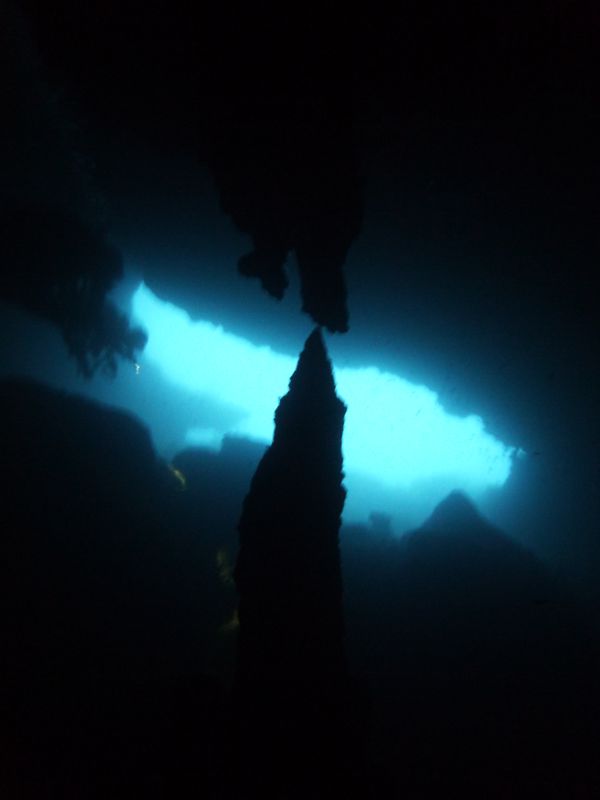
-600w.jpeg)
-600w.jpeg)
Released in 1982, this classic synthesizer inspired some of the sound design of the Olm. Its configuration of saw and square wave oscillators can be heard periodically playing strange melodies or chords.

The design of this rare instrument is the basis for the droning, swarm-like sounds that can be discovered while using the Olm. Note the beautiful wooden enclosure that also inspired my designs. While it may look like a vintage piece of equipment, these are actually relatively recent, though rare, first introduced in 2010.

This game for Nintendo 64, was everything.
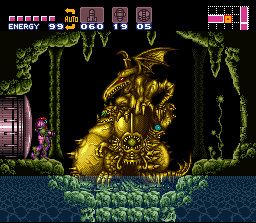
In this game for Super Nintendo, you explore labyrinthine caves on an alien planet.
Some notes on indeterminism #
While one might assume that the decision to incorporate randomness or indeterminacy into this project was influenced by the likes of John Cage or Iannis Xenakis, its roots are far removed from the likes of obligatory first-semester BFA courses – that I, admittedly, navigated with more enthusiasm than depth. Instead, the project bears the hallmark of a more basement-dwelling origin. The history of aleatoric music is rich and long, and certainly integral to this project, however, my most significant encounter with randomness has predominantly occurred within the context of video games. In that context, it is harnessed to craft dynamic environments and introduce distinctive challenges to players. In games such as Minecraft or Deep Rock Galactic, random number generation is used to generate the shape and structure of the game world, twisting caves–bottomless, contorted ravines, along with the many challenges within. By imposing constraints on randomization, games can manifest as a unified space, with predefined boundaries that frame the range of possible outcomes. For this project, I imagine the sound world as being cave-like in the way that it's gradually unveiled and only partially visible/audible at any given time. Indeterminism does not dictate the overall sound of the Olm; rather, it sculpts the auditory environment within predefined parameters.
Process #
For digital synthesis, I employed the Electro-Smith Daisy Seed as the processor, while designing and fabricating a custom circuit board to facilitate audio output and seamless interface integration. The Daisy Seed is programmed with a combination of Pure Data and C++. Power and volume controls, along with audio outputs are embedded in an aluminum shield. Construction of the housing for the piece is made of stained and varnished plywood. The sculpture that contains the interface is made of Ultracal 30, a durable plaster variant, and the sculpture is secured in the housing with brass hardware.
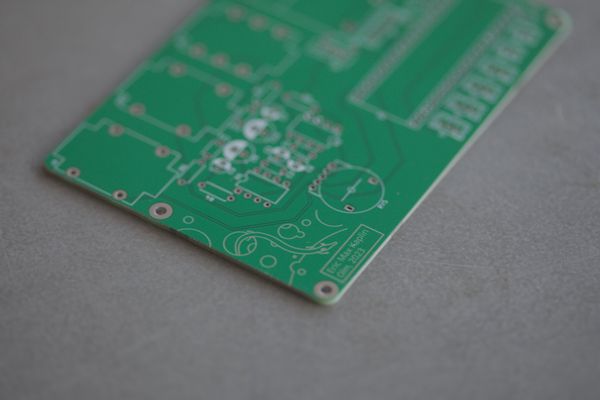
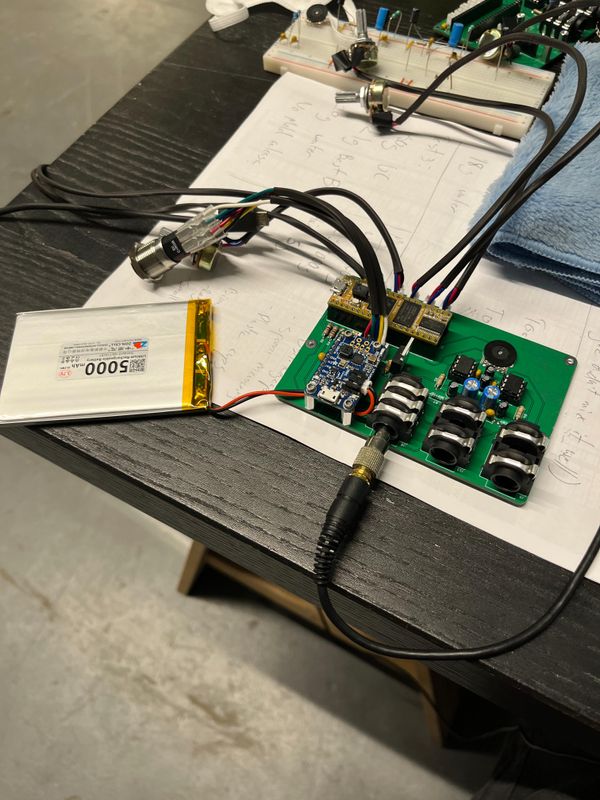

For more information on the process and techniques used in the Pure Data patch and Daisy Seed, you can visit the Olm-pd Github repo for source code and documentation.
To learn more about how the PCB was designed, you can visit the Olm-pcb Github repo for more information and schematics.
Credits #
- Aluminum plate CNC by Philippe Vancleemput
- Nick Everett & Evan Montpellier for the tools
- Asa for materials
- Background image from Wikimedia Commons[12]
Footnotes
e.g. Swiss cheese ↩︎
Arne Hodalič, CC BY-SA 3.0, via Wikimedia Commons ↩︎
Deep Rock Galactic, this file depicts work from a copyrighted video game or otherwise copyrighted material. The copyright for it is most likely owned by the developer and/or its affiliates or the person or organization that developed the concept. It is believed that its use here constitutes fair use. ↩︎ ↩︎
Mike Prosser, CC BY-SA 2.0, via Flickr ↩︎
Peretz Partensky from San Francisco, USA, CC BY-SA 2.0, via Wikimedia Commons ↩︎
Wusel007, CC BY-SA 3.0, via Wikimedia Commons ↩︎
deepsonic from Switzerland, CC BY 2.0, via Wikimedia Commons ↩︎
Big City Music, promotional image. Fair use. ↩︎
Zelda Fandom Wiki, This file depicts work from a copyrighted video game or otherwise copyrighted material. The copyright for it is most likely owned by either Nintendo and/or its affiliates or the person or organization that developed the concept. It is believed that its use here constitutes fair use. ↩︎
Metroid Recon, This file depicts work from a copyrighted video game or otherwise copyrighted material. The copyright for it is most likely owned by either Nintendo and/or its affiliates or the person or organization that developed the concept. It is believed that its use here constitutes fair use. ↩︎
James St. John, CC BY 2.0, via Wikimedia Commons ↩︎
